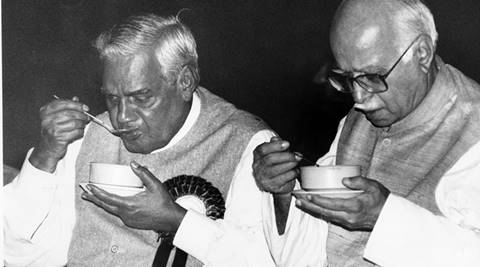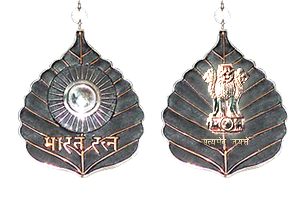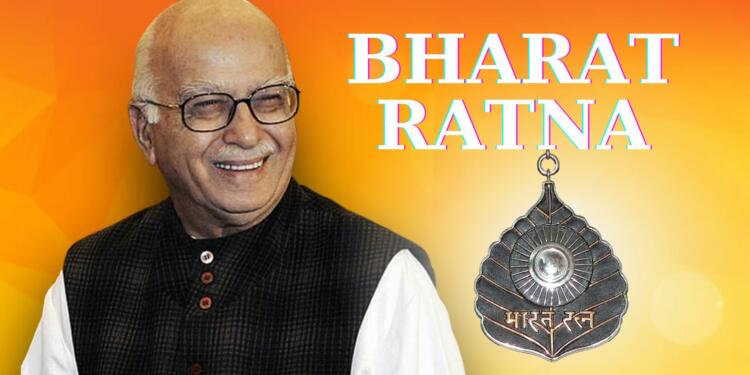Lal Krishna Advani’s indelible imprint on Indian politics is a saga of resilience, strategic acumen, and transformative leadership. Born in 1927 amidst the socio-political upheavals of undivided India, his journey began as a law student, evolving through the corridors of the Rashtriya Swayamsevak Sangh (RSS) and into the political landscape. Joining the Bharatiya Jana Sangh, he ascended to its presidency, laying the groundwork for the Bharatiya Janata Party’s (BJP) emergence. A defining accord with Atal Bihari Vajpayee and leadership in the Ram Janmabhoomi movement showcased his political prowess. The historic 1991 electoral triumph and subsequent role as Deputy Prime Minister added layers to his legacy. The pinnacle came in 2024 with the Ram Mandir inauguration and Bharat Ratna, affirming Advani’s enduring impact on India’s cultural and political narrative.
Early Life and Entry into Politics
Lal Krishna Advani, a prominent figure in Indian politics, was born on November 8, 1927, in Karachi, which was part of undivided India at the time. His early life was marked by the socio-political changes surrounding the Indian independence movement. Advani’s family, belonging to a middle-class background, instilled in him the values of education and community engagement.
Advani’s foray into politics began during his college years when he pursued law at Sindh Law College. It was during this period that he became associated with the Rashtriya Swayamsevak Sangh (RSS), a right-wing Hindu nationalist organization. The ideological foundation laid during his involvement with the RSS significantly influenced his political trajectory.
Joining the Bharatiya Jana Sangh (BJS)
In 1947, amidst the partition of India, Lal Krishna Advani joined the Bharatiya Jana Sangh (BJS), the political arm of the RSS. This marked a crucial step in his political journey, aligning him with the burgeoning right-wing movement in post-independence India. His leadership skills and dedication to the party’s cause were quickly recognized, leading to his steady climb through the party ranks.

Advani’s early years in the BJS set the stage for his later role in shaping the Bharatiya Janata Party (BJP). Serving as the BJS president from 1970 to 1973, he laid the groundwork for the transformation of the political landscape. This period marked the consolidation of his political influence and set the stage for a formidable partnership with Atal Bihari Vajpayee, another influential leader in the BJS.
Friendship with Vajpayee
A defining aspect of Advani’s political journey was his close friendship with Atal Bihari Vajpayee, another staunch in the BJS. This harmony extended beyond personal rapport to a formidable partnership that would shape the trajectory of the BJS and later the Bharatiya Janata Party (BJP).
The foundation of their relationship was built on shared political ideologies and a common commitment to the ideals of the Rashtriya Swayamsevak Sangh (RSS). As both leaders rose through the ranks of the BJS, their collaborative efforts were instrumental in shaping the party’s identity and vision. Their partnership extended beyond the political arena, reflecting a genuine personal connection that transcended ideological differences.
The duo’s synergy became even more evident during the turbulent times of the Ram Janmabhoomi movement. Advani’s leadership in mobilizing support for the construction of a Ram temple in Ayodhya was complemented by Vajpayee’s statesmanship. Together, they navigated the complexities of the movement, consolidating the Bharatiya Janata Party (BJP) as a major political force in the process.
The pinnacle of their collaboration came in 1998 when the BJP, under Vajpayee’s leadership as prime minister and Advani as deputy prime minister, formed the first non-Congress government at the Center. Advani’s role as the deputy prime minister showcased their ability to work in tandem, with each leader bringing their strengths to the table.

Despite occasional differences in approach, their friendship remained resilient, symbolizing a rare bond in the often tumultuous landscape of Indian politics. Their association became a model of political partnership, characterized by trust, shared vision, and a commitment to the broader ideals of the BJP. The legacy of Advani and Vajpayee’s relationship continues to resonate in India’s political history, leaving an indelible mark on the nation’s political landscape.
First Election: 2 Seats for the BJP
In the crucible of its first Lok Sabha election in 1984, the Bharatiya Janata Party (BJP) faced a formidable challenge, winning merely two seats. This modest electoral debut marked a watershed moment for the party, led by stalwarts like Lal Krishna Advani. Despite the apparent setback, this humble beginning set the stage for the BJP’s transformation into a formidable political force in the years to come. The resilience displayed in the face of adversity, with Advani securing one of the two seats, foreshadowed the party’s emergence as a major player, signaling a turning point in the political landscape of India.
Ram Janmabhoomi Movement
The Ram Janmabhoomi Movement, spearheaded by Lal Krishna Advani, unfolded as a pivotal episode in Indian history during the late 1980s and early 1990s. Centered around the disputed site in Ayodhya, believed to be the birthplace of Lord Ram, the movement called for the construction of a Ram temple at the location. Advani’s leadership played a crucial role in mobilizing widespread support for the cause, with the Bharatiya Janata Party (BJP) at the forefront. The movement, characterized by rallies, protests, and the iconic Rath Yatra in 1990, galvanized public sentiment and heightened communal tensions.

1990, Rath Yatra from Somnath to Ayodhya
In 1990, Advani embarked on a Rath Yatra, a chariot procession, from Somnath to Ayodhya. The purpose was to mobilize support for the Ram temple movement. Despite being met with controversy and violence, the Rath Yatra significantly raised the profile of the BJP and brought the Ayodhya issue to the national forefront.
BJP Wins 80+ Seats
In the 1991 Lok Sabha elections, the Bharatiya Janata Party (BJP) achieved a significant milestone by winning 80 seats, a remarkable upswing from its modest performance in 1984. Lal Krishna Advani’s strategic leadership played a pivotal role in this electoral success. His emphasis on Hindutva issues and his passionate advocacy for the Ram Janmabhoomi movement resonated with a substantial section of the electorate. Advani’s ability to mobilize support around these issues contributed to the BJP’s electoral gains, marking a turning point in the party’s fortunes. The outcome not only validated Advani’s approach but also showcased the party’s growing acceptance, laying the groundwork for its emergence as a formidable political force. This electoral triumph in 1991 underscored Advani’s political acumen and set the stage for the BJP’s continued ascendance in Indian politics.
Also Read: PM Modi has successfully sent Mamata in a state of shock and despair
Babri Demolition
On December 6, 1992, the Babri Masjid in Ayodhya was demolished by Hindu mobs. Advani, who had been mobilizing support for the Ram temple movement. The demolition, although stated as controversial, was also viewed positively as a watershed moment in Indian history. Advocates argue that it paved the way for the eventual construction of the Ram Mandir, fulfilling a long-standing aspiration of the Hindu majority. The event, while sparking debates and tensions, is seen by supporters as a decisive step towards reclaiming a sacred site. The subsequent resolution of the Ayodhya dispute and the inauguration of the Ram Mandir in 2024 are often connected to the events of 1992, portraying them as crucial chapters in India’s cultural and religious narrative.
BJP’s Victory in Subsequent State Elections and Formation of First Atal Bihari Government
Following the controversial Babri Masjid demolition in 1992, the Bharatiya Janata Party (BJP) faced both challenges and triumphs. Despite the contentious event, the BJP continued to gain support in subsequent state elections during the 1990s. The party’s electoral success culminated in the formation of the first non-Congress government at the Center in 1998. Atal Bihari Vajpayee assumed the role of prime minister, with Lal Krishna Advani serving as the deputy prime minister. This historic moment marked a significant departure from the traditional political landscape, symbolizing the ascent of the BJP to the forefront of Indian politics and establishing a new era of governance under the leadership of Vajpayee and Advani.
A stint as Deputy Prime Minister
Lal Krishna Advani’s stint as Deputy Prime Minister marked a pivotal phase in Indian governance. Serving from 2002 to 2004, Advani played a crucial role in shaping policies and programs under Prime Minister Atal Bihari Vajpayee’s leadership. His influence extended beyond ceremonial duties, contributing significantly to the Bharatiya Janata Party’s (BJP) governance. Advani’s tenure witnessed diplomatic initiatives, economic reforms, and a focus on national security. His strategic acumen and political experience solidified his status as one of the most powerful figures in the Indian government during that period, leaving an indelible impact on the trajectory of the nation’s policies and political landscape.
Inauguration of Ram Mandir and Bharat Ratna
Lal Krishna Advani reached the pinnacle of his political journey with the realization of a long-cherished dream for the Hindu right wing – the inauguration of the Ram Mandir. Acknowledged as a key figure behind the project’s successful completion, Advani’s presence at the ceremony marked a momentous occasion. Further adding to this accolade, the veteran leader was honored with the Bharat Ratna, India’s highest civilian award. Prime Minister Narendra Modi personally conveyed this announcement through a social media post, expressing his joy and extending congratulations to Advani. Modi praised Advani’s monumental contributions to India’s development, highlighting his distinguished roles as Deputy Prime Minister, Home Minister, and I&B Minister. The recognition, Modi emphasized, was a tribute to Advani’s unwavering commitment to transparency, integrity, national unity, and cultural resurgence throughout his decades-long service in public life.

Critics Call Him Divisive
This is widely acknowledged. Advani’s association with Hindutva ideology and events like the 1990 Rath Yatra are seen by many as contributing to communal tensions and religious polarization. Many call him a bad influence on India. Lal Krishna Advani, despite facing criticism, stands as a pivotal figure in India’s political narrative, with several noteworthy contributions that deserve recognition.
Architect of Hindu Unity: While labeled divisive by some, Advani’s role in making Hindu unity a political reality cannot be denied. He effectively mobilized a significant section of the Hindu population, contributing to the political landscape and empowering a previously fragmented community.
Political Strategist: Advani played a crucial part in initiating the political decline of the Congress party. His strategic leadership in the Bharatiya Janata Party (BJP) challenged the Congress hegemony, paving the way for a new era in Indian politics that Prime Minister Modi later capitalized on and concluded.
Initiator of Ram Janmabhoomi Movement: Advani’s initiation of the Ram Janmabhoomi movement marked a historic chapter, awakening national sentiments. While controversial, this movement paved the way for the eventual construction of the Ram Mandir, a dream realized in 2024 under Prime Minister Modi’s leadership.
Integral Role in BJP’s Ascendancy: His leadership was instrumental in the BJP’s ascendancy, and the subsequent victories in state elections reflected the growing acceptance of the party. Advani’s strategic vision laid the foundation for the BJP’s transformation into a major political force, a legacy that continues to shape Indian politics.
Bharat Ratna Deserving Recognition
Lal Krishna Advani’s receipt of the Bharat Ratna is a deserving recognition of his profound impact on Indian politics. As a key architect of Hindu unity and initiator of the Ram Janmabhoomi movement, Advani played a pivotal role in shaping the nation’s narrative. His strategic acumen, integral role in BJP’s ascendancy, and contributions to challenging Congress’s dominance mark a significant chapter in India’s political history. The Bharat Ratna acknowledges not only his individual achievements but also the transformative movements he spearheaded, contributing to the cultural and political resurgence of the nation.

In the annals of Indian politics, Lal Krishna Advani’s journey emerges as a transformative odyssey, intricately woven into the fabric of the nation’s history. From his early association with the Rashtriya Swayamsevak Sangh to his instrumental role in the formation and ascent of the Bharatiya Janata Party (BJP), Advani’s legacy is a tapestry of resilience and strategic brilliance. The bond shared with Atal Bihari Vajpayee and the pivotal role in the Ram Janmabhoomi movement stand as testaments to his enduring impact. The inauguration of the Ram Mandir, a crowning achievement, and the Bharat Ratna bestowed upon him affirm the recognition of a statesman whose contributions shaped India’s cultural and political resurgence. In the nuanced tapestry of Indian politics, Lal Krishna Advani’s significance persists, leaving an indelible imprint that transcends temporal divides.





























